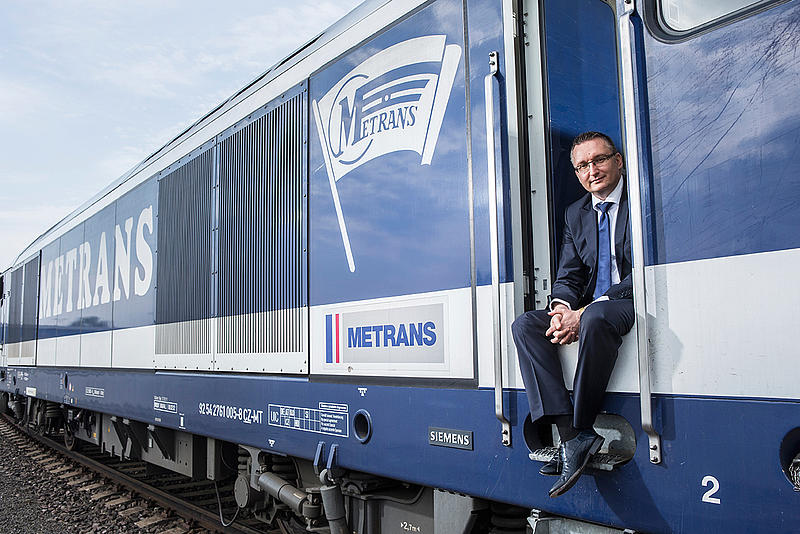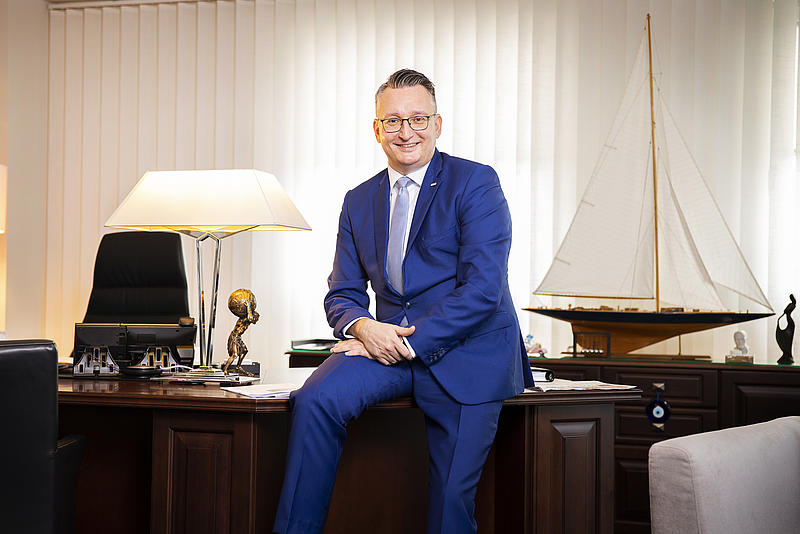Peter, does everyone in the company call you by your first name?
That’s funny, because everybody calls me “PK” … it’s easier, not as formal. I started using these initials at the beginning of my career. Easy to memorise, quick to write down if you want to forward some info. And somehow it became a daily routine. A lot of times I hear, or read, “Have you asked PK?”, “Can we speak with PK?” In Czech or Slovak its not the English “pi-kay”, it’s “pe-ka”. And it became familiar.
How would you describe the Metrans spirit 30 years after its foundation?
Nowadays the Metrans Team has over 2,000 colleagues. This is big and it’s great! Our network covers many European countries, but we are still – like in the beginning – a family. The Metrans family.
What makes the Metrans family different?
Maybe the family thing? No, but seriously, I think Metrans was the first one in Central and Eastern Europe with a big idea that we were able to realise. This is the idea of a service solution, a neutral one, which helps you in different situations. If you need it to be all inclusive OR if you need only a specific solution, then Metrans is your partner.
And although much has changed in the market, we still follow the same strategy. We went into new markets, we became a railway operator with our own assets like the locomotives and railcars, but we still do and always will stick to our goal: to be a NEUTRAL SERVICE OPERATOR with terminals, trains and additional services. A company that is able to react flexibly and offer custom-made solutions as well. And we stick to this. We are not a freight forwarder; we do not intend to change or cross borders within the transportation business.

Can you explain what keeps you personally attached to the company?
I joined Metrans around 1999 because of its vision. I have known Jiri Samek, the founder of Metrans and long-time CEO, since 1995 when we started working together. At that time, Metrans became a customer of my previous employer. Indeed, Metrans was not the easiest customer; they had new ideas and approaches, but finally it worked. I was probably already following our segment in this period. I enjoyed the brainstorming with Jiri, but also with other colleagues.
In 1999 we decided to re-start intermodal transport in Slovakia and also to develop Hungary as a further step. This new challenge was the “click” moment. I decided immediately to join Metrans, and we opened the third terminal in Dunajska Streda. At 22, I became the CEO of the Slovakian branch of Metrans. Now there are 17 terminals working in our network.
You can call that an impressive success. What still drives you?
Many things have changed over such a long period, but the foundation remains the same – it’s still the vision, the idea and the great team of colleagues surrounding me. You have to enjoy this! Because when you enjoy what you do, it works. And even through pandemics, issues with the Suez canal, financial crises – we made it! Every day brings opportunities. Sometimes more, sometimes fewer. It’s also important to me that we are free to decide, free to form strategies, to make the difference. This also comes with a lot of responsibility, but with this team it works.
Comparing the business to when you just started: what challenges did you face?
We could lament the worsening conditions, lacking railway infrastructure, bigger vessels and their scheduled inaccuracy causing waves in the transportation chain. But would this make sense? These poor conditions are exactly the challenges that fuel improvement and let us prove that we are problem-solvers. Our business is about personal relationships. And this is something we should always keep in mind: it’s about people, for people. Even in these times of dynamic digitalisation.
What are the biggest challenges for Metrans today?
Our biggest challenge is to maintain the high level of quality in the work that we are doing for our customers. When the pandemic started, railway transportation proved that it serves us even in these difficult times that arose pretty much overnight. But, when we would like to provide more trains, we have to fight for each and every line in the timetable.

Is rail transport infrastructure reaching its limits?
The basic infrastructure is what we are missing. You have to look at what cargo freight needs, too. Currently, personal traffic has the highest priority and cargo freight is in second place.
We are all familiar with political proclamations regarding the transfer of long-haul transports from road to rail and the reduction of CO2 emissions connected to this. Real steps are required, otherwise these goals will remain theoretical only. We hope that with cooperation and with all the associations where we are part, we will be able to achieve something. In addition to our normal daily work, some politics is also involved.
How do you see the New Silk Road? Is it the next big thing?
On the Silk Road we are still a “newcomer”, we only started a few years ago. Our idea was to show that Central and Eastern Europe plays a special role and has great potential. We believed that we could build a similar business to what we started to build in the 1991 for maritime traffic, but this time for land.
And yes, it will grow bigger over the years. But freight cargo is essentially just a different type of passenger. This means the cargo has a destination and as a “passenger” within the free market, it will definitely find the best transportation solution.
What is your part in this relatively complicated business?
We provide a high frequency of trains coming in to the eastern part of our network. We have connected the projects Malaszewicze–Ceska Trebova and Dobra–Dunajska Streda. Short transit time is the main advantage of the New Silk Road, and we bring even more speed into it. Basically, we brought the Silk Road to Central Europe, and Central Europe then delivers to the local market. We also forward into the western part of Europe.
Where are you looking for the next opportunities?
We are increasing the size of the network; we are investing in the future to create railway hubs that will be backbones of the intermodal solutions. There is the Zalaegerszeg project in Hungary, where the terminal will be a totally new start and a new approach. The terminal will be an open access terminal, on the main line to/from the Adriatic. All ports will go to one crossing point with fast reloading and further distribution.
These relations to south-eastern Europe will create further possibilities, even in the logistics sector. When you take a look on Dunajska Streda, we have good neighbours who have taken up the challenge and have warehouses close to the terminal. It’s a similar situation in Ceska Trebova: we have freight stations and distribution centres that were attracted to the nearby terminal and have also invested.
We always look at possibilities from this point of view: what is the added value that we can offer to the client, to the customer? And that’s the way we think. It has to have this “special touch”, because moving a train from A to B is too easy. We like a challenge!

